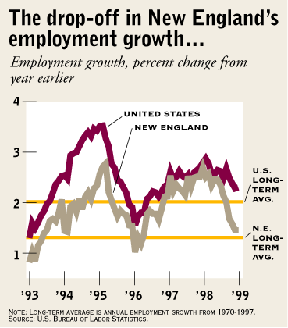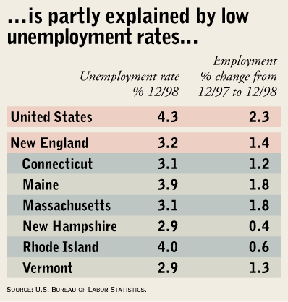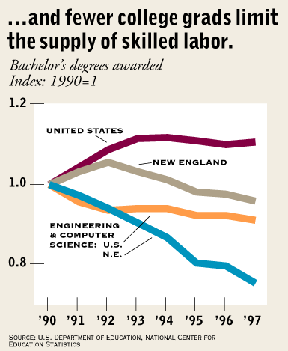Issues in Economics: New England Continues to Grow, but More Slowly Than the Nation 
Over the past several months, the New England economy has continued to chug along in good shape, although the rate of employment growth - the single best indicator of current economic conditions - has slowed. As a recent Wall Street Journal article put it "The party isn't over, but the band is getting tired."
Nationally, employment continues to expand at a rate above its long-term average of 2 percent. However, New England's employment growth, which had been tracking the national trend fairly closely until the early months of 1998, began to slow. As of December, the region's employment count was 1.4 percent above the year-earlier level. Admittedly, this latest figure is still in line with New England's long-term growth rate. Nevertheless, it is important to understand why New England's growth rate has slowed, for this may hold lessons for the region and, potentially, the nation.
ARE WE IN THE "WRONG" INDUSTRIES?
The first possible explanation for slower growth in New England is that the region's employment is concentrated in the "wrong" industries. Traditionally, New England has been more oriented toward manufacturing than most other regions. Since manufacturing tends to be cyclically sensitive, this has made our regional economy particularly vulnerable during national recessions. And, within manufacturing, New England's exposure to defense and minicomputers contributed to the especially severe regional downturn in the late 1980s and early 1990s. But while New England was once far more reliant on manufacturing than the nation, this is no longer the case. In the 1950s, over 40 percent of New England's nonfarm jobs were in manufacturing, 9 percentage points higher than in the nation. As recently as a decade ago, manufacturing's share of employment, although below the level of the 1950s, was still much larger than the nation. Today, after continued layoffs, only 16 percent of New England jobs remain in manufacturing, barely higher than the national share of 15 percent. And within manufacturing, the mix of New England's activity has shifted toward growth industries such as telecommunications and medical equipment, plastics, and biotechnology.
While its manufacturing sector has shrunk, New England has experienced relatively rapid growth in services. Services accounted for only 12 percent of employment in both the region and the nation in the 1950s. Today, services industries have expanded to about 33 percent of New England jobs, higher than the 29 percent share they hold nationally.
Given the higher concentration in services and rough parity in manufacturing's shares, industry mix is an unlikely explanation for the region's slower job growth. With services expanding faster than manufacturing nationally, in fact, New England currently has an industry mix that is ever so slightly favorable.
IS IT ASIA?
The second possible explanation for New England's recent slowdown is a disproportionate sensitivity to national and international shocks. In late summer and early fall, it appeared that the nation was undergoing a stock market correction. If this had continued, we might have seen a greater impact on New England than on the country as a whole, given the above-average wealth of the region's residents and the importance of financial-sector employment in places such as Boston and Stamford. But, the stock market rebounded and by late January the Dow was still hovering above 9000.
Thus, the only sustained "shock" has been the deterioration in foreign economies - principally Asia. But the patterns of recent employment growth suggest that foreign economic problems are probably not responsible for New England's slower growth. Apart from natural resources industries (which play a relatively minor role in New England), manufacturing is the sector that is most exposed to foreign trade. In New England, manufacturing went from adding jobs in 1997 to shedding them in 1998. Yet, the rate of decline in manufacturing employment was roughly similar to the United States as a whole. In fact, New England's relative slowdown has been concentrated in non-manufacturing jobs.
Merchandise exports tell a similar story. New England firms ship a similar fraction of their merchandise exports to Japan and other Asian nations as compared to that of the rest of the U.S. And, both the nation and region are below their 1997 export peaks by roughly similar rates - 9 percent for the U.S., and 11 percent for New England.
Competition from imports may also have had some negative impact. Locally, exposure to manufactured imports probably is greatest in paper, jewelry and toys, textiles, and machine tools, where firms are cutting back on employment. But, on balance, industry employment and trade patterns confirm that while New England has been hurt by difficulties overseas, it has not been hurt more than the nation.
LABOR SHORTAGES
The most compelling explanation for New England's employment slowdown is a shortage of workers. As of December, New England's unemployment rate was 3.2 percent, about a percentage point below the national rate and 0.9 percent lower than a year ago. Every state in the region had a rate below the U.S. average. Massachusetts, Connecticut, and New Hampshire, with rates near 3 percent, have had the sharpest declines in job growth. Massachusetts' employment growth dropped from over 3 percent during 1997 to 1.8 percent this past year; Connecticut's fell from 2.5 percent to 1.2 percent; New Hampshire's from 1.9 percent to 0.4 percent. Maine experienced a sizable slowdown in job growth even though its unemployment rate was near 4 percent, but this may be because Maine's vast rural areas have substantial structural unemployment, which tends to mask very low unemployment in other parts of the state.
New England's relatively slow-growing labor force is an additional factor. Over the past year, New England has had no net increase in its labor force, compared to 1 percent growth nationally. Thus, this region truly is "hitting the wall" with respect to labor availability.
Our labor force traditionally has grown more slowly than the nation's because trend population growth is lower, but this situation has been exacerbated in the 1990s by relatively large declines in the number of college graduates. For the nation, new college graduates increased in number by 11 percent from 1990 to 1993, then remained fairly level. In New England, the number rose by 5 percent between 1990 and 1992, then declined by 10 percent through 1997. And, although engineering and computer science have become less popular majors nationwide in the 1990s (contributing to pervasive shortages in these fields), the decline has been more precipitous in New England. Whatever the underlying causes, it seems plausible that the decrease in students graduating within this region is another reason why it has been difficult to sustain growth in the skilled labor force and in employment.
WHAT WE CAN LEARN
What are the overall implications of this regional slowdown? The preceding analysis suggests that regional job growth is likely to remain below its 1997 pace, regardless of whether the national economy strengthens or weakens in coming months. As for national policy, does the New England experience provide any evidence on the ramifications of very tight labor markets? For professional and technical employees, and nonmanufacturing employees in general, anecdotal evidence from New England indicates that firms are experiencing hiring delays, but not large pay increases - with the possible exception of substantial pay hikes for information technology positions. Since the year 2000 is lurking, companies cannot avoid trying to outbid each other for IT people. But New England's recent experience suggests that companies are seemingly (and surprisingly) flexible and patient with respect to hires in other fields.
Yolanda K. Kodrzycki is Economist and Assistant Vice President at the Boston Fed.




 About the Authors
About the Authors
Yolanda K. Kodrzycki



